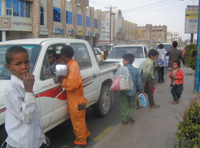
MENA education is at the crossroads: An international report [Archives:2008/1127/Reportage]
February 7 2008
 |
A new World Bank report released Feb. 4 states that education is at the crossroads for the future of the Middle East and North Africa (MENA). Entitled, “The Road Not Traveled – Education Reform in MENA,” the report plays a crucial role in promoting poverty alleviation and economic growth both at the national and individual household levels.
In the statement, the World Bank asserts that countries in the region must advance reform in three areas: shifting emphasis on buildings and material inputs to results and partnership with stakeholders, shifting management practices toward incentives to promote better performance and responsiveness of education service providers and finally, shifting from accountability to the state to accountability to the public to ensure that education as a public good reaches the greatest number of citizens.
In his keynote address, Marwan Muasher, World Bank senior vice president for external affairs, highlighted the need for more reforms. “The quality of education in the region hasn't kept up with the needs of the economy. Education systems don't adequately support the development of girls' and boys' analytical skills, problem solving skills, critical thinking and innovation. It's time to pay greater attention to these skills, to reach – if not even exceed – the level of attention given to illiteracy and school enrollment,” he added.
“There's widely shared recognition of the critical role that education plays in shaping the opportunities for young people in the MENA region, as well as strong political commitment to making education more relevant to the needs of today's economy. Educational reform is urgent in order to address the challenge of unemployment and integrate into the global economy,” says Daniela Gressani, World Bank vice president for the Middle East and North Africa region.
Important points
The following are some of the important points the report mentions.
The modern history of educational reform in the MENA region is a tale of ambition, accomplishment, falling short and unfinished business. The region has accomplished much along this path; for example, most children benefit from compulsory schooling, quite a few have opportunities to continue their formal education and learning outcomes have improved.
While such achievements are impressive, particularly considering the point from which they started during the 1960s, gaps remain between what education systems have attained and what the region needs in order to achieve its current and future development objectives.
MENA countries continue to lag behind many comparable countries, as measured by years of educational attainment in the adult population. Educational achievements to date are compromised partially by high dropout rates and relatively low scores on international tests.
Despite remarkable improvements in expanding access and closing gender disparity at the primary education level, adult literacy remains low and education systems don't produce the necessary skills for an increasingly competitive world. Unemployment is particularly high among graduates and a large segment of the educated labor force is employed by governments. Consequently, the link between education and economic growth, income distribution and poverty reduction is weak.
Over the past 40 years, MENA countries on average have dedicated 5 percent of their gross domestic product and 20 percent of government expenditures to education, which is more than other developing countries with similar per capita income levels. As a result, the region has been able to improve equitable access to education at all levels of instruction.
These are impressive achievements, considering that MENA began in the 1960s with some of the world's lowest educational indicators. With some exceptions, MENA countries have reached nearly full enrollment in primary education and increased secondary school enrollment nearly threefold between 1970 and 2003 and fivefold at the higher education level.
Although the region essentially has caught up with East Asia and Latin America regarding full primary enrollment, it still lags behind in secondary and higher education enrollment. Consequently, the average number of years of schooling in MENA is lower than both regions by more than one year.
Additionally, the distribution of education attainment (measured by the standard deviation of years of schooling) has become more unequal over time compared with either Latin America or East Asia.
Furthermore, literacy rates remain below those of other regions. Although the differences have decreased since the 1950s, illiteracy within the MENA region remains twice as high as in East Asia and Latin America.
Although international test results indicate that outcomes are close to what would be predicted considering GDP per capita and enrollment rates, they remain below those found in fast developing middle income countries, such as the South Korea and Malaysia.
In more than half of MENA countries, approximately two-thirds of students major in social science and humanities rather than in science and mathematics. This enrollment pattern is the opposite of that observed in East Asia and, to a lesser extent, in Latin America.
Given that technological innovation and adaptation increasingly is playing a prominent role in the development process, MENA schools may be producing the wrong mix of competencies.
The report's primary conclusion is that regional education systems must follow a new path of reform, which path has two features: the first is a new approach to educational reform wherein the focus is on incentives and public accountability, along with inputs to education systems; the other emphasizes closing the gap between the supply of educated individuals and both internal and external labor demand.
——
[archive-e:1127-v:15-y:2008-d:2008-02-07-p:report]


